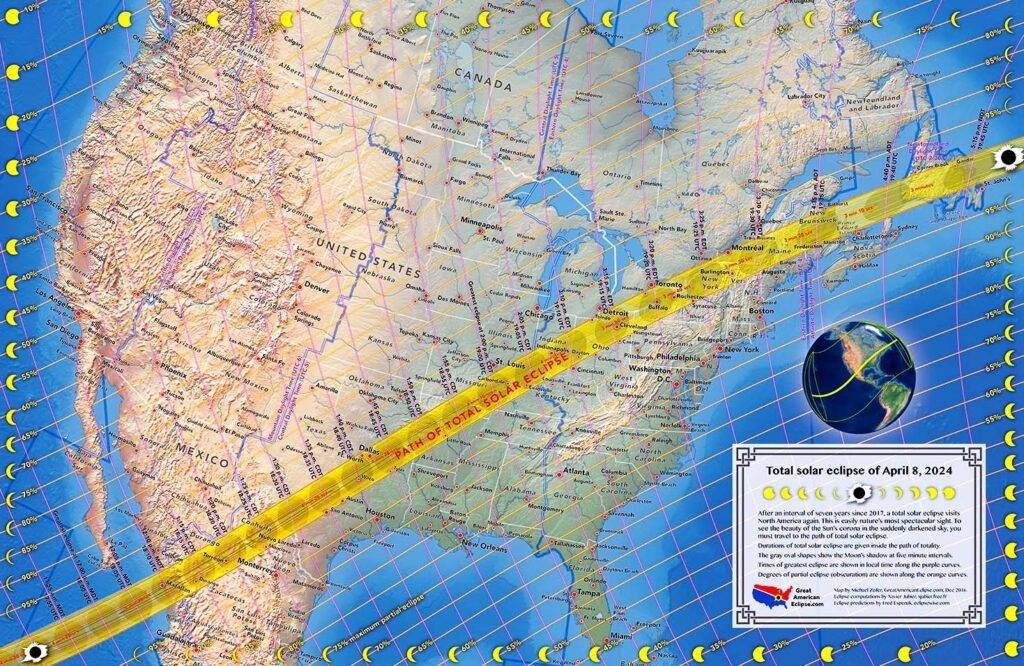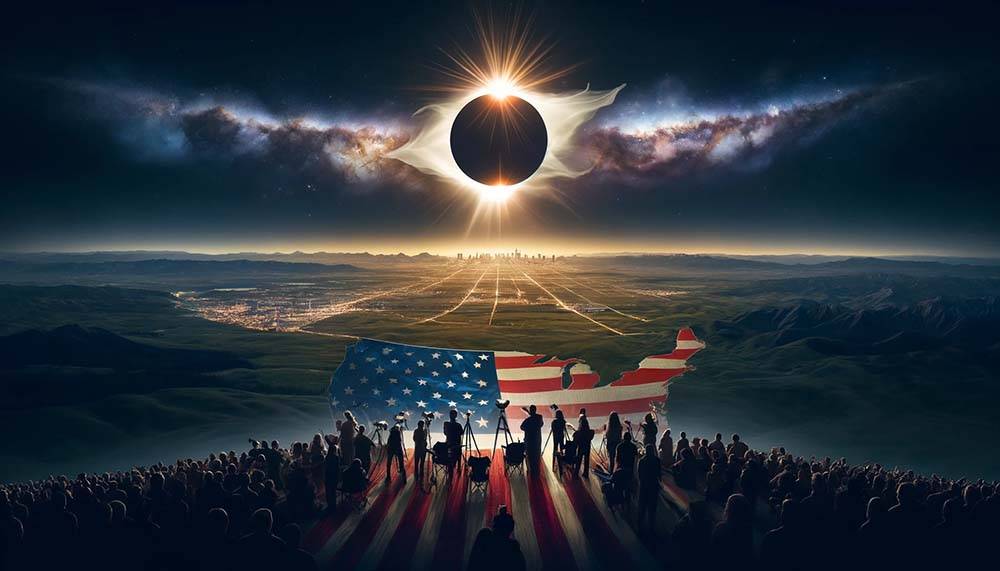
Unity and Wonder Under the American Sky: Celebrating the 2024 Total Solar Eclipse
Mark your calendars for April 8, 2024, as North America prepares for a magnificent total solar eclipse, the first of its magnitude since 2017. This awe-inspiring event will trace a path through Mexico, across 15 U.S. states, and into southeastern Canada, offering a unique spectacle of the moon completely obscuring the sun.
A Journey Across the Continent: The Path of Totality
The eclipse’s path, known as the “path of totality,” will stretch approximately 115 miles wide, enveloping regions in darkness and revealing the sun’s radiant corona. Observers along this path will experience the surreal transformation from day to night, feeling a drop in temperature as daylight stars emerge. This phenomenon underscores the grandeur of our universe and the pivotal role of celestial events in America’s historical narrative.
Eclipse Milestones and Viewing Essentials
The eclipse journey begins near Pu‘uali‘i, Hawaii, and makes landfall in Mazatlán, Mexico, before sweeping across the U.S. from Texas to Maine, and finally departing from Newfoundland, Canada. Key viewing locations along this path will offer varying durations of totality, with the longest eclipse experience near Nazas, Durango, Mexico.
For those outside the path of totality, a partial eclipse will still present a remarkable sight, especially since we are in the peak of sun activity. Cities across North America will witness the moon taking a significant “bite” out of the sun, with locations like Dallas and Montreal experiencing the full spectacle of totality.
- Partial eclipse begins near Pu‘uali‘i, Hawaii at 06:27 a.m. local time (12:27 p.m. EDT, 1627 GMT).
- Total solar eclipse makes landfall: Mazatlán, Sinaloa, Mexico at 9:51 a.m. local time (12:51 p.m. EDT, 16:51 GMT).
- First location to experience totality: Mazatlán, Sinaloa, Mexico at 11:07 a.m. local time (2:07 p.m. EDT, 1807 GMT)
- First location to experience totality in the U.S.: Near Florentino Ramos Colonia, Texas at 1:27 p.m. local time (2:27 p.m. EDT, 1827 GMT).
- Eclipse leaves North America: The eclipse will depart land from the Atlantic coast of Newfoundland and Labrador. The total solar eclipse ends at 5:16 p.m. local time (3:46 p.m. EDT, 1946 GMT). With the partial eclipse phase ending at 6:18 p.m. local time (4:48 p.m. EDT, 2048 GMT).
A Celestial Event Steeped in American Spirit

The 2024 total solar eclipse is not merely an astronomical event; it’s a celebration of the enduring spirit of discovery and wonder that characterizes the American ethos. This eclipse invites us to reflect on our place in the cosmos and the principles of natural law that govern our constitutional republic.
Preparation and Participation: Embracing the Eclipse
To safely enjoy the eclipse, proper viewing glasses are essential during the partial phases, while totality offers a brief opportunity to observe the sun’s corona directly. This event encourages communities to come together, sharing in the wonder and fostering a collective appreciation for the grandeur of our universe.
Here are the most notable places to catch the 2024 total solar eclipse:
| Location | Totality (local time) | Totality duration |
|---|---|---|
| Mazatlán, Sinaloa, Mexico | 11:07 a.m. MST | 4 minutes 20 seconds |
| Durango, Durango, Mexico | 12:12 p.m. CST | 3 minutes 50 seconds |
| Torreón, Coahuila, Mexico | 12:16 p.m. CST | 4 minutes 11 seconds |
| Piedras Negras, Coahuila, Mexico/Eagle Pass, Texas, U.S | 1:27 p.m. CDT | 4 minutes 24 seconds |
| Kerrville, Texas, U.S | 1:32 p.m. CDT | 4 minutes 25 seconds |
| Fredericksburg, Texas, U.S | 1:32 p.m CDT | 4 minutes 25 seconds |
| Dallas, Texas, U.S | 1:40 p.m. CDT | 3 minutes 52 seconds |
| Idabel, Oklahoma | U.S: 1:45 p.m CDT | 4 minutes 19 seconds |
| Russellville, Arkansas, U.S | 1:49 p.m. CDT | 4 minutes 12 seconds |
| Cape Girardeau, Missouri, U.S | 1:58 p.m. CDT | 4 minutes 7 seconds |
| Carbondale, Illinois, U.S | 1:59 p.m. CDT | 4 minutes 10 seconds |
| Bloomington, Indiana, U.S | 3:04 p.m. EDT | 4 minutes 3 seconds |
| Indianapolis, Indiana, U.S | 3:06 p.m. EDT | 3 minutes 51 seconds |
| Cleveland, Ohio, U.S | 3:13 p.m. EDT | 3 minutes 50 seconds |
| Erie, Pennsylvania | U.S: 3:16 p.m. EDT | 3 minutes 43 seconds |
| Rochester, New York, U.S | 3:20 p.m. EDT | 3 minutes 40 seconds |
| Montpelier, Vermont, U.S | 3:27 p.m. EDT | 1 minutes 42 seconds |
| Oakfield, Maine, U.S | 3:31 p.m. EDT | 3 minutes 23 seconds |
| Niagara Falls, Ontario, Canada | 3:18 p.m. EDT | 3 minutes 31 seconds |
| Montreal, Quebec, Canada | 3:26 p.m. EDT | 1 minute 57 seconds |
| Miramichi, New Brunswick, Canada | 4:34 p.m. ADT | 3 minutes 8 seconds |
| Tignish, Prince Edward Island, Canada | 4:35 p.m. ADT | 3 minutes 12 seconds |
| Catalina, Newfoundland, Canada | 5:13 p.m. NDT | 2 minutes 53 seconds |
Looking Ahead: Future Eclipses and American Heritage
Post-2024, the next total solar eclipse will occur in 2026, with future events casting shadows across various parts of North America. These celestial occurrences are not just scientific phenomena but moments that unite us in awe and reflection, offering opportunities to ponder our nation’s journey under the vast, starlit sky.
In embracing the 2024 total solar eclipse, we celebrate not only the marvels of the heavens but also the foundational principles of freedom and exploration that define our great nation. This event is a powerful reminder of America’s place in the broader universe and the patriotic spirit that guides our quest for knowledge and truth.
Are you venturing out to a location in order to capture this event with your own eyes? Do you already live in the path? Let us know in the comments below.
